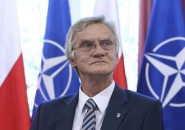Recommended:
- The Smolensk Conferences. A Preliminary Summary and Conclusion
- NEW STUDY: Putin's Russian inquiry into the Polish Air Force One crash in Smolensk
- 15 SIMPLE FACTS THE WORLD SHOULD KNOW
- Smolensk Reader's Digest. 23 pages, all the facts.
- Polish Military Intelligence was warned of a possible terrorist threat against one of the EU Member States' aircraft.
- Story behind the "1:24"
The conclusion that the wing of the Tu-154 aircraft, which crashed in Smolensk was torn apart by the explosion, is based on a simulation and a three-dimensional model, said Kazimierz Nowaczyk, Chairman of the Smolensk Subcommittee on Wednesday.
The subcommittee operating at the Defense Ministry said that, on Wednesday at the plenary meeting of the subcommittee, its expert, Frank Taylor, stated that the left wing of the aircraft “was destroyed by an internal explosion;” there were several sources of explosion in the wing and center wing, which is confirmed by the analysis of the way the aircraft's doors hit the ground, and “the birch did not affect the original destruction of the wing.”
“The 3D model shows how it happened”
Nowaczyk told TVP Info that Taylor considered not only the results of the subcommittee's expert opinions but also the method used. It consisted, added Nowaczyk, of an analysis of tens of thousands of photographs and the preparation of a three-dimensional model.
“The 3D model of wing breakthrough and model of the first section, which should hit the birch, are the so-called slots, i.e. the extended section of the wing,” said the acting head of the subcommittee.
He added that the directions of bends were analyzed, where the source of energy came from and what caused changes in the shape of part of the aircraft, and the reconstruction of the wing allowed to find out how the wing was destroyed.
“It was destroyed by explosions, internally disrupted, the 3D model shows how it happened,” he said.
“There must have been extra energy.”
Nowaczyk also expressed an opinion that the explosion and the depth at which the plane's door stuck into the ground speak for the explosion.
As he said, this conclusion was achieved “with the help of a simulation made by one of the best centers in the world that has US certificates, all such things.” “It was clearly stated that they had to be driven at a speed of at least a hundred meters per second (...) while the plane dropped at a speed of 12 m/s. It means only one thing - extra energy had to be supplied to them, it is impossible for the door to speed up to such speed itself,” said Nowaczyk.
A fragment of a film was also shown on TVP Info, in which Taylor confesses that he had no doubts that an explosion occurred on the plane.
As the subcommittee said on Wednesday, the proposals adopted by its members “constitute one of the key conclusions of the technical report.” On Monday, the Defense Minister Antoni Macierewicz expressed his conviction that the report would be ready in April, the eighth anniversary of the disaster.
Source; PAP - Polish Press Agency





